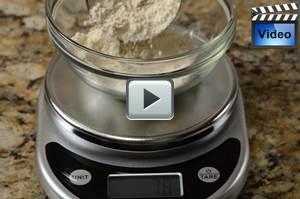|
|
| Subscribe Now |
As you know, baking is about precision and accuracy and that's why I've always been an advocate of weight measurements. As you've probably noticed, all the recipes on joyofbaking.com give both volume and weight measurements. For example if a recipe calls for all purpose flour, it is written "1 cup (130 grams) all purpose flour". The reason I write recipes in this way is that depending on where you live you may use volume (cup) measurements or you may weigh (grams) your ingredients.
I believe the reason home bakers in the United States haven't adopted weight measurements is because digital scales were once hard to find and if you could find one, they were expensive. This is not the case any longer. Today you can find digital scales on line or in most stores that sell kitchen equipment. And what is amazing is that some brands of digital scales sell for less than twenty dollars. That's about the same price as a good set of stainless steel measuring cups.
Professionals seldom measure their ingredients by volume (cups). They usually prefer measuring by weight, and there are many reasons for this. Baking is not like cooking where you can add a little extra of this ingredient or leave out that ingredient. Baking is all about precision and accuracy so that you can achieve consistent results. And there are so many variables when baking - your ingredients, how you measure your ingredients, the mixing technique, your pans, temperature and humidity, and your oven. Some of these variables are hard to control, but you can control accuracy by weighing ingredients. Unfortunately this is not always true when measuring by volume (cups), especially with dry ingredients. One excellent example is flour. If you "dip" the measuring cup into the flour bag you will get a different amount of flour than if you "spoon" the flour into your measuring cup. This is because flour tends to compact with transportation and storage and there is also the problem of humidity affecting its' density (volume). However, neither of these things will affect the weight of flour. Because a 130 grams of flour is always 130 grams of flour.
Weighing ingredients is about accuracy, but it's also makes things quicker and easier. A scale is so simple to use. All you need to do is 'zero' your scale, place the ingredient on the scale, and you're done. You can even weigh one ingredient after another, in the same bowl, by just "zeroing" your scale. No need to worry anymore about whether you should "dip" or "spoon" your flour into your measuring cup.
Lastly, you may wonder why I use 'grams' (metric) instead of 'ounces' when I live in the United States where metric is not used. The reason is 'gram' measurements are so much easier to work with. You can scale a recipe up or down with little effort. But the major reason is because the word "ounce" can refer to both volume (capacity) and weight (mass). There are 'weight' ounces and there are 'fluid' ounces. For example, you can have 4 ounces of flour (weight) and 4 fluid ounces of milk (volume). Totally different things. And speaking of the metric system. Another question often asked is why does 1 cup of flour weigh 130 grams while 1 cup of granulated white sugar weighs 200 grams, when they are both 1 cup measurements? The answer is easily explained when you think about 1 cup of feathers and 1 cup of rocks. Everyone knows these two things don't weigh the same amount even though they have the same volume. The same holds true for ingredients as density, therefore weight, does vary from ingredient to ingredient.
Hopefully you will try weighing, at least your dry ingredients. Below is a chart listing some commonly used dry ingredients with their corresponding volume and weight measurements. While this chart is by no means complete, it's a good start and feel free to add your own list of ingredients and their weights for easy reference. The weight measurements listed for each ingredient have been used to test all the recipes on the site.
| Ingredient | Volume (Cups) | Weight (grams) |
|---|---|---|
| Butter (Salted or Unsalted) | 1/2 cup | 113 grams |
| Butter (Salted or Unsalted) | 1 cup | 226 grams |
| Flour (All purpose or plain) | 1 cup | 130 grams |
| Flour (Cake) | 1 cup | 120 grams |
| Flour (Whole Wheat) | 1 cup | 130 grams |
| Potato Flour | 1 tablespoon | 12 grams |
| Potato Flour | 1/2 cup | 80 grams |
| Corn Starch (Corn flour) | 1 tablespoon | 10 grams |
| Ground Almonds (Almond Meal or Flour) | 1 cup | 90 grams |
| Cornmeal | 1 cup | 120 grams |
| Sugar (Granulated White) | 1 cup | 200 grams |
| Sugar (Brown) (lightly packed) | 1 cup | 210 grams |
| Confectioners Sugar (Powdered or Icing) | 1 cup | 120 grams |
| Chocolate Chips | 1 cup | 170 grams |
| Cocoa Powder (varies by brand) | 1 tablespoon | 6 grams |
| Cocoa Powder (varies by brand) | 1 cup | 100 grams |
| Graham Cracker Crumbs | 1 cup | 100 grams |
| Old Fashioned Rolled Oats | 1 cup | 95 grams |
